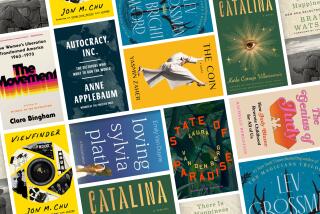Finally, a Follow-Up Novel to ‘Invisible Man’
- Share via
When the novelist Ralph Ellison died nearly five years ago, the status of his long-awaited follow-up to the 1952 classic “Invisible Man” was unclear. Eight short stories that he had published since 1960 were pieces of his novel in progress, but a completed manuscript would have to be mined from his Harlem apartment. “I did have the impression it was close to being finished,” Joe Fox, Ellison’s editor at Random House, said at the time.
But only now is the book finally ready for publication--by Random House in June under the title “Juneteenth,” the name of a celebration marking the emancipation of Texas slaves on June 19, 1865. The publishing house did not trumpet this literary event with a special announcement, instead heralding publication in its summer catalog, which was circulated to booksellers earlier this month.
“It was a very, very long novel that needed to be cut,” said Random House publisher Ann Godoff. “But no extra material was needed to make it work. It’s quite a remarkable piece of work--and all his own.”
The cutting was done by John F. Callahan, Ellison’s literary executor, who earlier edited the posthumous “Collected Essays of Ralph Ellison” (Modern Library, 1995) and “Flying Home and Other Stories” (Vintage), a 1996 collection that included some previously unpublished stories discovered in the writer’s apartment.
*
In the introduction to “Flying Home,” Callahan recalled that Ellison had spoken of the novel that would become “Juneteenth” shortly before his death at age 80, saying that “the damn transitions are still giving me fits, but I’m having fun.”
However, the pages Ellison left behind, representing 40 years of work, presented a daunting challenge. Callahan, on sabbatical from the faculty of Lewis & Clark College in Portland, Ore., recalled in an interview three years ago that Ellison’s novel “had erupted in chaos over his desk, chair, computer table and copying machine, finally covering the floor like a blizzard of ash.” Some of Ellison’s notes were written on magazine subscription cards.
Reached last week, Callahan said that “Juneteenth” derives from 410 pages of this chaos, what he called “the most finished and coherent and free-standing” portion, a discrete unit of what Ellison had envisioned as a much larger saga.
“Is it a finished novel?” Callahan asked. “Damn near it.”
A much longer scholarly edition of “Juneteenth,” complete with additional drafts and author notes, will be published later.
And what is “Juneteenth” about? The story, set in the 1950s, centers on the son of a mixed marriage who goes on to become a race-baiting U.S. senator and later is shot by a black man on the Senate floor. Ellison, an Oklahoma City native, wrote the novel in flashbacks, as related during a deathbed conversation between the senator and a mysterious black minister from Oklahoma, whom he summons to his side.
*
Random House’s catalog describes “Juneteenth” as a “jazz novel, a sermon, a song of praise to the richness of the African American experience . . . an autobiographical reckoning with Ellison’s own life journey.”
“Ellison had come to terms with how black are all Americans,” said Scott Moyers, the Random House editor who is shepherding the book to publication. “The answer is: profoundly black. Blackness is in the culture and the music. It’s in the ground water.”
Moyers added: “Ellison’s widow, Fanny, was convinced that Callahan had done a terrific job and represented what her husband wanted.”
According to Callahan, Ellison’s contract called for him to deliver his second novel on Nov. 1, 1967. That he missed the deadline is common in book publishing. Moreover, a fire later that same month at his summer home in the Berkshires in Massachusetts further delayed him because it destroyed a section of his manuscript.
As the years passed, Ellison apparently had no pressing financial need to turn in the novel and get it on sale because he received continuing royalties from sales of “Invisible Man” and income from various teaching positions, including a stint at New York University in the 1970s.
“Why didn’t he ever finish the book? There’s a mystery about it,” Callahan went on. “I don’t think we know. He kept working on it, though. He enjoyed working on it. But it was a source of tension with him.”
An early excerpt will appear in the New Yorker. Random House plans to promote “Juneteenth” by presenting readings from the novel and distributing a guide to the book for reading groups. The company also intends to advertise the work in a number of black-oriented newspapers.
In the meantime, Callahan said, some of Ellison’s letters--to his mother, his friend Richard Wright, African American scholars and others--will be published shortly in an issue of the New Republic. Callahan is hoping that a book of Ellison’s letters will follow.
Afterwords: Bloomberg, L.P., the broadcaster and publisher of news and financial information, has added to its print offerings. Bloomberg Wealth Manager, a third magazine branded with the name of company founder Michael R. Bloomberg, is aimed at financial advisors serving high-end clients. The premiere January / February issue comes with a circulation guarantee of 45,000 copies.
Caroline Graham, who became West Coast editor of the New Yorker under former top editor Tina Brown, is leaving the magazine to become West Coast editor of Talk, the general-interest monthly that Brown will launch in September.
Paul Colford’s e-mail address is paul.colford@newsday.com
More to Read
Sign up for our Book Club newsletter
Get the latest news, events and more from the Los Angeles Times Book Club, and help us get L.A. reading and talking.
You may occasionally receive promotional content from the Los Angeles Times.









